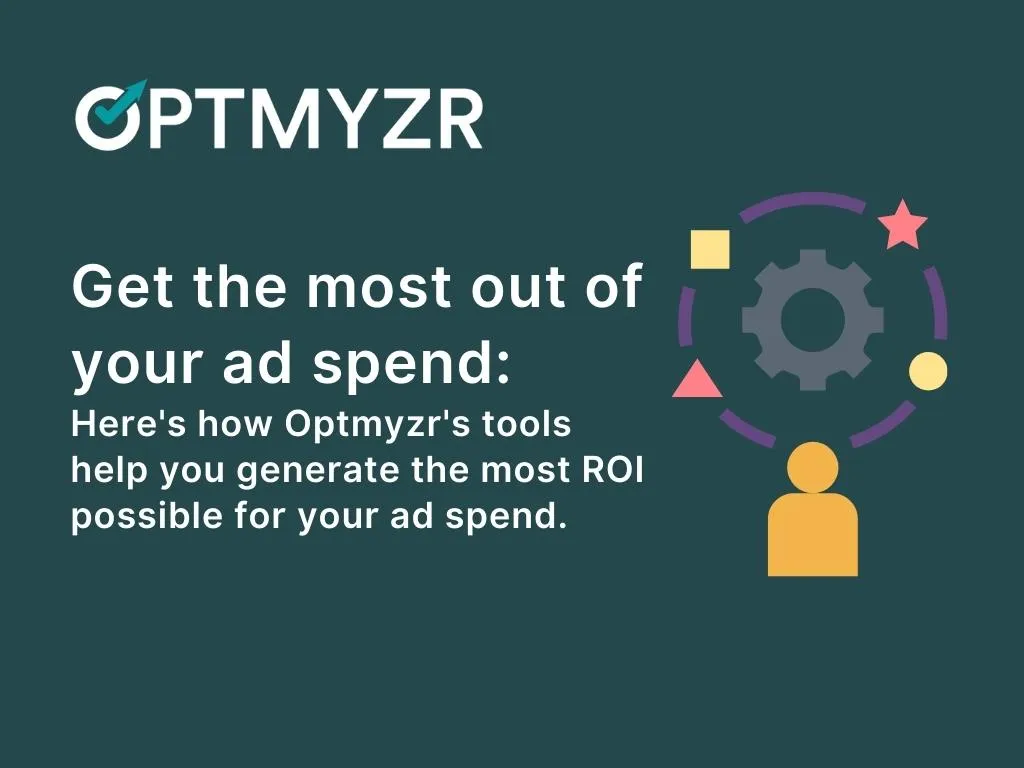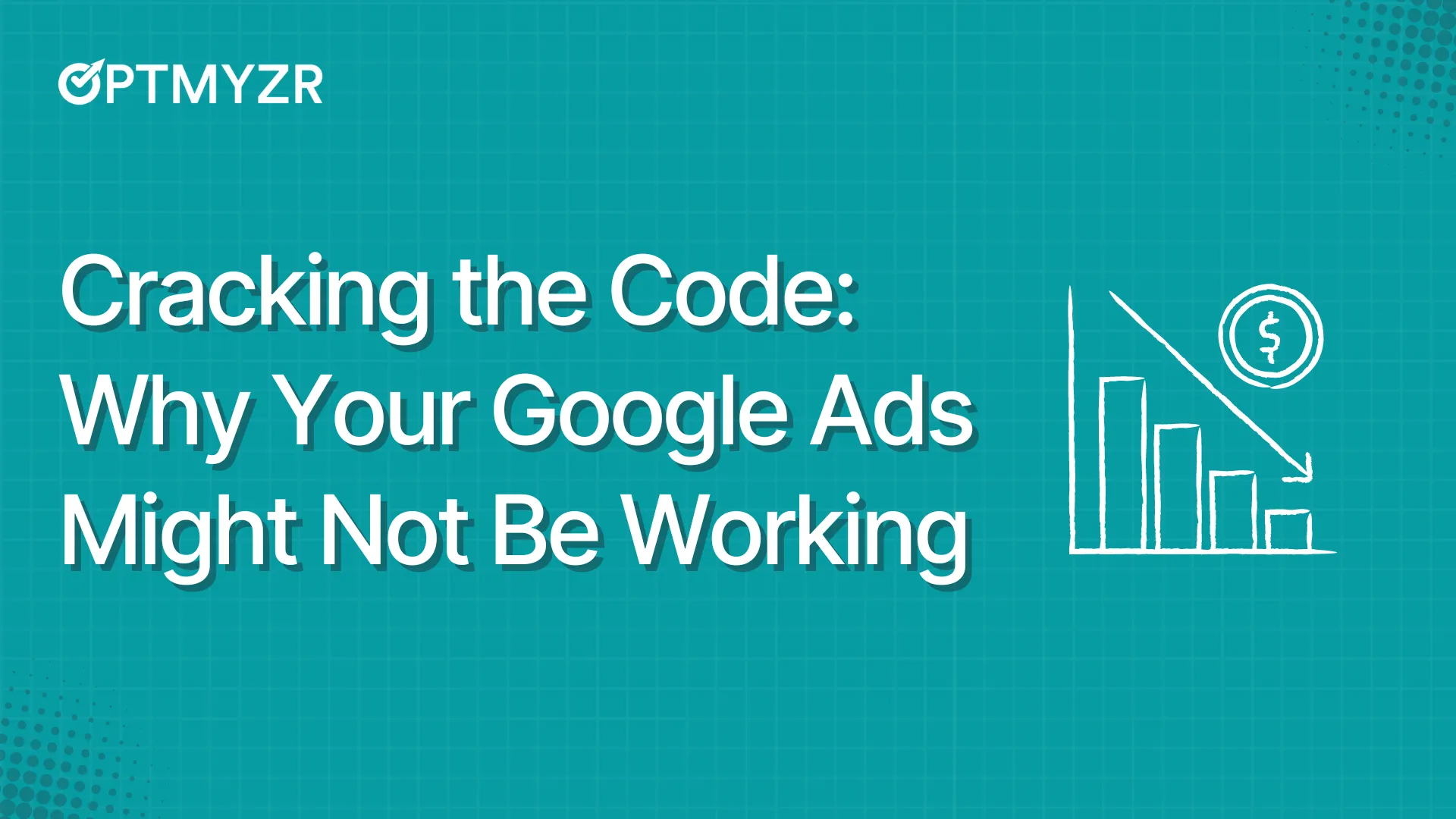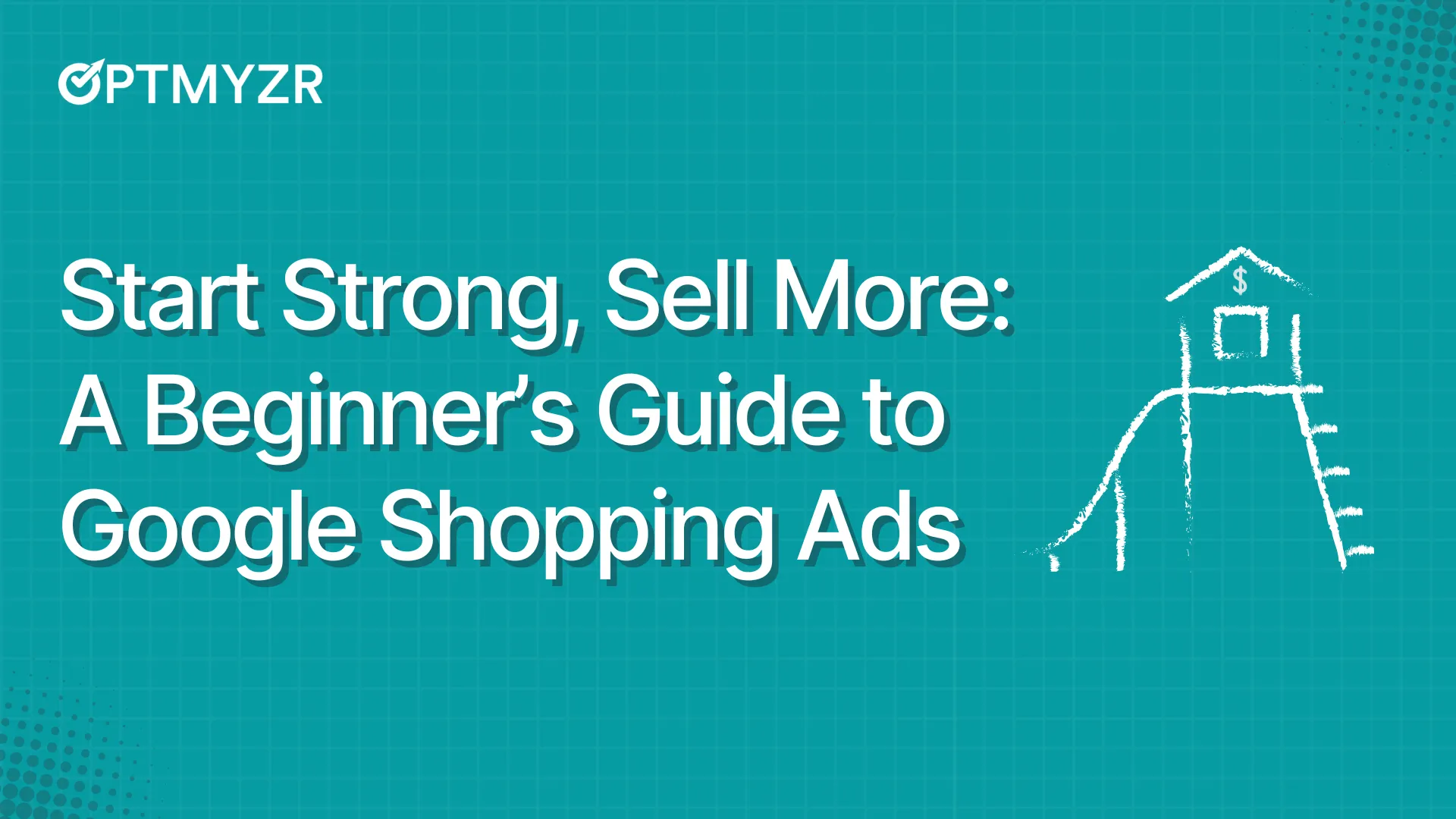At the height of the Roman Empire, pepper was so highly prized that spice traders’ wealth grew faster than they could spend it. And nowhere was it more available and expensive than in Italia province where Rome stood – and where the average income was higher than that of the entire empire.
In a way, Roman traders were the progenitors of value-based bidding by putting their most profitable merchandise in front of those likeliest to pay the most for it.
Today, it’s a Google Ads’ methodology to help advertisers maximize the conversion value of their ad spend, and one of several cards you can play to unlevel a playing field where every advertiser is using the same automation.
But things have changed a little bit since the Romans were in charge, and there’s more to value-based bidding than starting a price war over spices.
Put value-based bidding to the test with Optmyzr’s VBB tools
• Score audience segments
• Optimize conversion value rules
• Track campaign experiments
How Bidding To Value Works In Google Ads
In 2021, around 80% of Alphabet’s $257 billion in revenue came from Google’s advertising channels including search, shopping, and YouTube – that’s a huge ecosystem of people searching for products and information.
With it, Google has acquired a staggeringly large data set rich with consumer intent to inform its decisions. This is paired with world-class AI and machine learning that helps advertisers make the right decisions for their clients and businesses.
But that data is incomplete; it doesn’t account for account-specific information like who bought from you via a Google advertisement but later returned their purchase, or how one customer from geo 1 may have 10x the value of a customer from geo 2.
Value-based bidding closes that information gap by telling Google what your business considers to be the most and least valuable sources of traffic.
On our video podcast, PPC Town Hall, Google explained to us everything about Value-Based Bidding: how it works, best practices to follow, and common pitfalls to avoid.
Get actionable PPC tips, strategies, and tactics from industry experts twice a month.
Bidding to value happens when you tell Google things that Smart Bidding can’t measure, such as:
- How much a customer is worth to your business, revenue stream, and profitability
- Which conversions turned out to be money in the bank and which ones didn’t
- The steps a lead took online or offline after converting via Google that resulted in revenue, and how much you value each of these conversion action steps
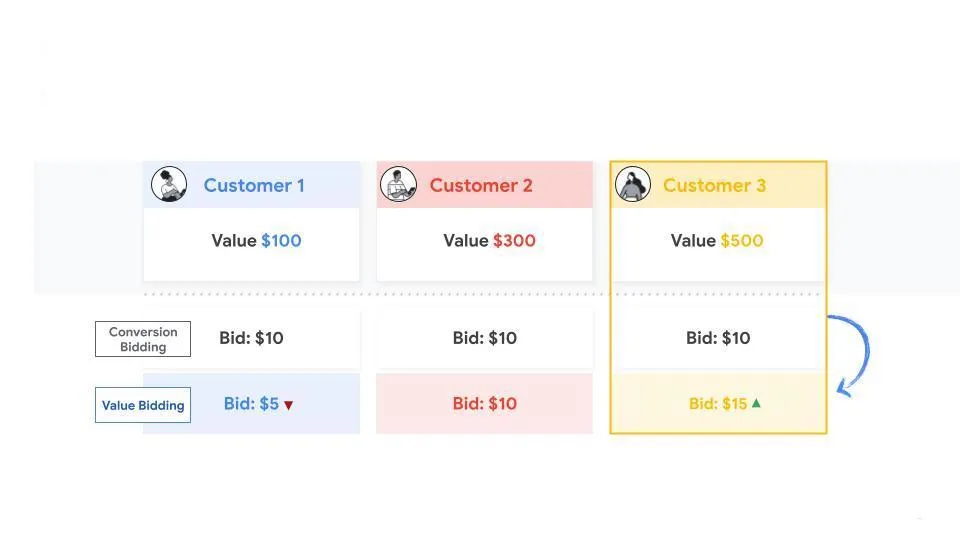
This graph is a hypothetical example of how value-based bidding helps you maximize your conversion value; it’s not how value-based bidding works in all cases. It’s possible to generate a higher volume of lower conversion value customers as well. The goal is to maximize conversion value, not the number of conversions.
Traditional conversion-based bidding methods don’t account for this level of nuance. With value-based strategies, you spend more of your budget acquiring customers most likely to create profit for your business.
In short:
- Differentiate your customers. It’s likely you already segment customers based on their value to your business, but Google doesn’t have this information.
- Bid on what matters. With a value-based bid strategy, Google learns which potential customers are most valuable to you.
- Drive increased performance. Bidding higher on more valuable customers delivers incremental revenue lift and profitability.
Remember that different Google channels have different prerequisites and settings to enable value-based bidding. With Smart Shopping migrated to Performance Max, the only option is bidding to value. Search and Standard Shopping give you a choice between conversion-based or value-based strategies.
Read more: Optmyzr’s Guide to Google Ads Performance Max Campaigns
4-Point Framework For Value-Based Bidding
1. Share Better Data
There are two broad ways to share data with Google.
Online Conversions
Global Site Tag and Google Tag Manager help you pass back online data points with additional tag parameters at the time of conversion, to help Google understand a conversion’s value.
Conversion data makes or breaks your success with value-based bidding. Be sure to set up and track more accurate conversions that match your business goals.
Some advertisers still use pageviews and other low-touch actions as conversions. We suggest something more indicative of interest, such as a form submission or purchase.
Offline Conversions
Offline Conversion Imports let you directly import conversions that took place offline, which you can pass back to Google via tools like Zapier, direct CRM integrations with Salesforce and HubSpot, or by uploading formatted spreadsheets. Anyone who clicks on your ad gets assigned a Google Click ID (GCLID). Use this anonymous identifier to report back on their conversion path while keeping customer data private.
For an advertiser who sells cosmetic products using an omnichannel strategy, using Offline Conversion Imports can tell Google data associated with different GCLIDs. For example:
- True transaction value after a customer makes a full or partial return
- Different values for first-time vs. repeat customers
- The purchase value of a transaction in-store, with or without clicking on a digital ad
Offline Conversion Imports applies data up to 90 days old to the bidding algorithm (anything outside is used for reporting purposes only). You can either share the information daily and use conversion adjustments later on (Google-recommended best practice), or delay uploading conversions until you know more as long as it meets this threshold.
You can also use the Offline Conversions API in Google Marketing Platform to upload offline actions into Campaign Manager, Search Ads 360, and Display & Video 360 keyed to a DoubleClick User ID, GCLID, Device ID, or Match ID to view offline conversions.
Learn: All about Offline Conversions from Google
Read More: 3 Ways to Improve Smart Bidding Performance on Google Ads
Practice: How to Add GCLID Data to Google Analytics
2. Assign Clear Conversion Values
We’ve talked about the importance of using conversion values, but how do you decide what numbers to use? Consider these elements the next time you set them up for an account.
Estimated Value: This is your most educated guess as to how much money a conversion has or will generate. Depending on your needs, you could consider immediate top-line (revenue), bottom-line (profit and margin), forecasted profit, or customer lifetime value.
Implementation: With conversion tracking enabled, different conversions can have different values. You can also choose to assign the same value to all conversions if your business model demands it. Three ways to assign values include:
- Ecommerce Transaction Value: For online stores with shopping carts, your conversion values can vary based on the item. One conversion could be worth $25, while another could be worth many multiples.
- Profit Margin: If your average order value (AOV) is $3,000 with a 45% profit margin, and your CRM shows that 20% of leads become customers, your conversion value would be (3,000 x .45 x .20) $270.
- Lifetime Value: For the same AOV but using LTV modeling, you find that customers spend an additional $5,000 on average over their lifetime. At the same profit margin, your profit per customer is $3,600 ($3,000 + $5,000)*(.45). With a 20% conversion rate, your conversion value is $720.
Frequency: Pass value data back to Google as quickly and consistently as possible, ideally daily. This allows your account to get as close as possible to real-time optimization – especially necessary for ecommerce and verticals where inventory is limited.
Remember not to get caught up with exact figures – it’s fine to use estimates. Ensuring the values closely represent your business objectives is the most important part of this strategy.
Learn: Win quality leads with Smart Bidding and Offline Conversions
3. Build Rules For Conversion Values
Conversion Value Rules is a Google Ads feature that lets you tell their system more about how you value traffic based on three conditions:
- Location
- Audience (including first-party and Google Audience lists)
- Device
Value Rules are applied at the account or cross-account level on top of your base conversion value. This makes it critical that you work with your clients or other teams to understand the hierarchy of audiences, locations, and devices for your business.
Software businesses that generate leads can use Value Rules to share business insights with Google such as:
- Users in the United States are 3x more valuable (LTV or transaction value) than the average conversion (location)
- Users who signed up for their newsletter are 20% more valuable (audience)
- Users who browse on a desktop are 50% less valuable (device)
You should only create Conversion Value Rules that can’t be observed by or shared with Google through other means. For example, the profit margin isn’t known to Google; customer LTV per lead can only be inferred from your CRM database.
If you already share ecommerce transaction value through Google Shopping, for example, then Google already knows the differential in transaction value for consumers in geos and will take this into account within the Smart Bidding algorithm. So no Conversion Value Rules are needed in this case.
Outside of Value Rules, you can also use these other techniques to adjust conversion values:
- Conversion adjustments to retract and restate previously reported conversions reported online or through Offline Conversion Import.
- Data exclusions tell Smart Bidding to ignore all data from a particular date range when conversion tracking data was inactive or broken. This tool does not adjust for fluctuations in conversions.
- Pre-import adjustments allow you to modify the value based on a variety of factors that you control. This will help guide Smart Bidding to achieve your value objectives.
Improve: Optmyzr’s Value Rules guide and FAQ
Understand: What happens if a customer meets the conditions for multiple rules?
4. Pick The Right Bid Strategy
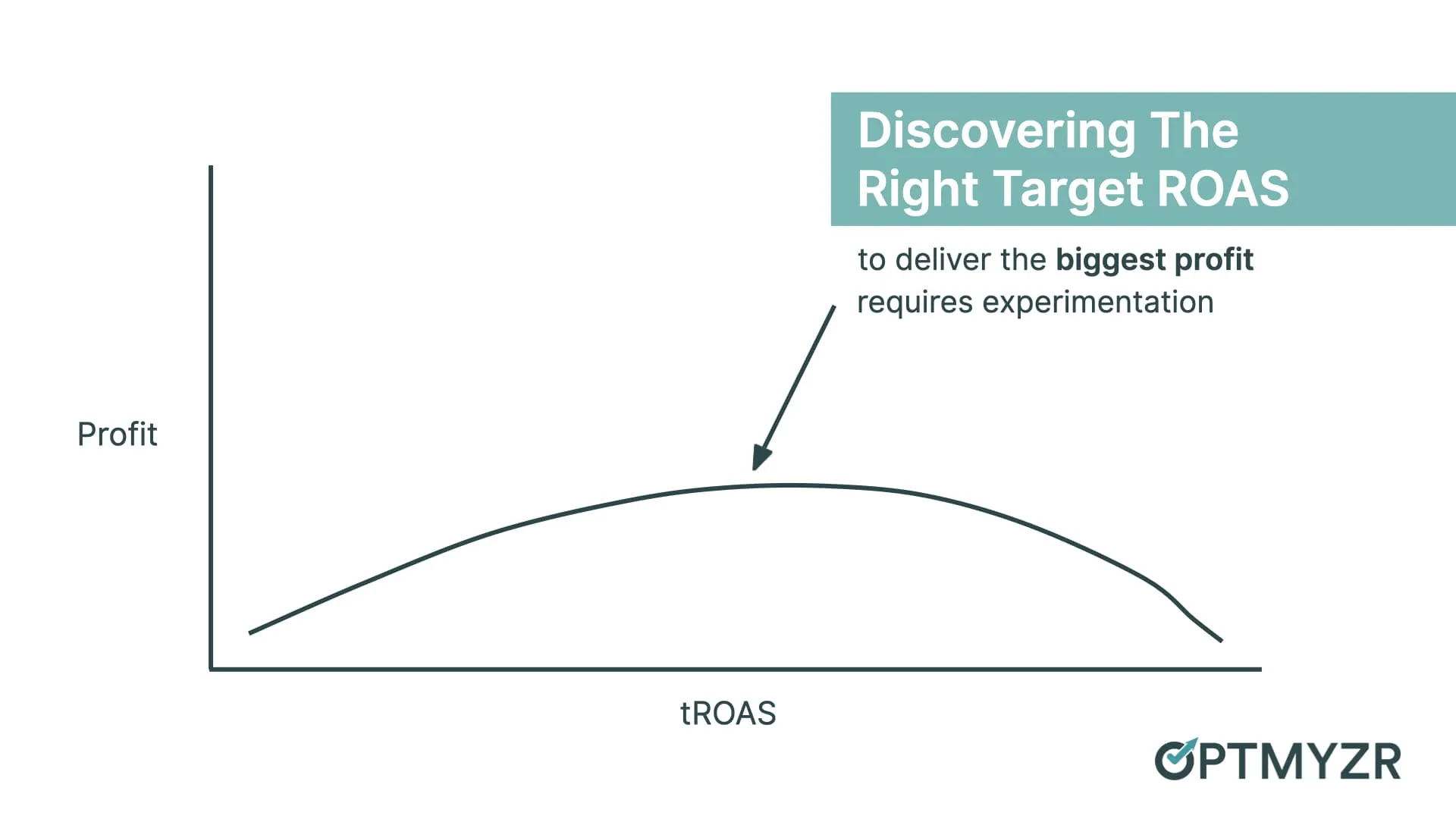
Maximize Conversion Value (with or without a target ROAS) is the definitive Smart Bidding strategy for businesses with varied products or customers with different values.
Maximize Conversions isn’t recommended unless you only sell a single product variant, or have no information to differentiate the value of one type of lead vs. another. When using this bid strategy, Google will optimize for conversion number and will not consider differences in conversion values.
The addition of a target ROAS simply tells Smart Bidding to maximize your conversion value within a certain spend threshold. But remember that too high a target can limit conversions, and too low a target can eat into profits. Be sure to experiment with your ROAS target to find the sweet spot.
The Impact Of Value-Based Bidding On PPC Performance
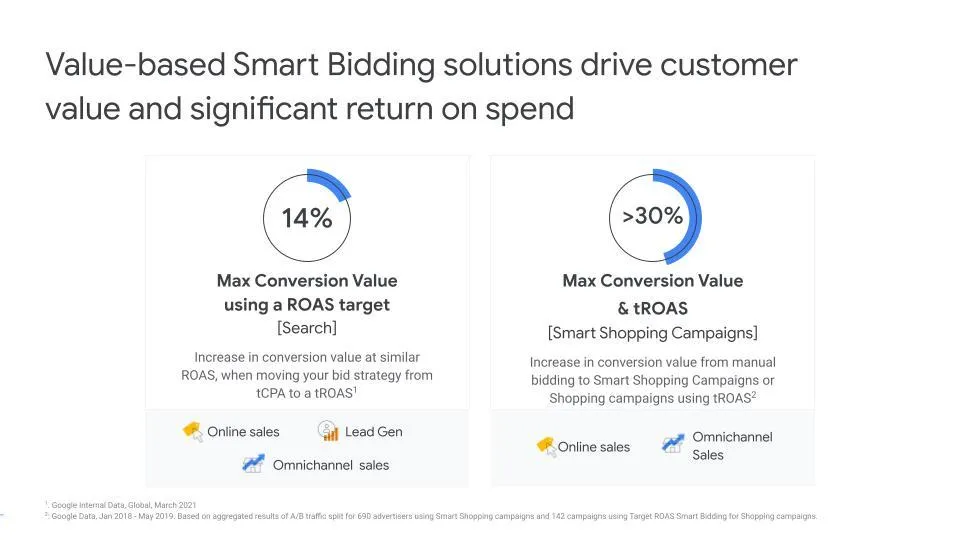
The numbers speak for themselves – Google’s internal data from 2021 shows clear gains from bidding to value using Maximize Conversion Value with a target ROAS. Search campaigns enjoy a 14% lift in conversion value at a similar ROAS, while Standard Shopping campaigns with tROAS can see a lift upwards of 30%.
Aside from the tangibles, value-based bidding offers operational and strategic advantages for any agency or brand.
Closer Alignment With Google
Bidding to value – and setting up the systems that make it possible – allows Google to focus on the quality and total conversion value of people who see your ads. This allows you to optimize campaigns to match your true business goals, better reflect your business’ observable data, and optimize to what matters – like revenue, profit, or customer lifetime value.
Better Post-Conversion Optimization
With better traffic comes a more manageable post-conversion process. If your business engages with customers extensively between online conversion and sale, you can optimize for customer LTVs rather than lead volume. What’s most important is that you report conversions (with values) back to Google to better align bidding with business outcomes and marketing objectives.
Showcase Strategic Value
It’s easier to make a case for how your agency or team adds value to the marketing landscape with value-based bidding. This will become increasingly important as Google automates more of its platform and uses Smart Bidding to help advertising capture the most business value with your Google campaigns.
Simply optimizing keywords and optimizing manual campaigns is no longer a viable role. With real-time optimization, you can account for nuances in value when using target ROAS and Maximize Conversion Value.
You can help to translate the performance of Google Marketing campaigns to be directly aligned with ultimate business goals for your client and bring first-party data in to assert your competitive advantage.
Implementing Your Value-Based Bid Strategy: A Checklist
Watch Taylor Mathauer and Will Gray from WebMechanix share how they used Value-Based Bidding to generate higher-quality leads for their client.
You will learn:
- Why they decided to use value-based bidding
- Success with value-based bidding
- The state of smart bidding and limitations with value-based bidding
- Where they’ve seen value-based bidding not work
- Requirements for using value-based bidding
- When is value-based bidding appropriate
- How to track success with value-based bidding
Most advertisers have now made the transition from manual to automated bidding, but that’s not where the road to PPC optimization should end. There are many forms of automated bidding, some more powerful than others.
Value-based bidding is the current state-of-the-art in bid management for Google Ads, but it relies on advertisers assigning a value to conversions so Google’s algorithms can prioritize more lucrative conversions.
Bidding to value works for a wide variety of advertising goals, but because it uses a target ROAS, it’s sometimes incorrectly assumed that it’s only for ecommerce.
Even lead-gen advertisers can use value-based bidding because they also get different values from different types of leads. The trick is simply in how to communicate these different values to the automated bidding systems.
This next part is the guide that will help you be successful as you transition your campaigns to a value-based optimization methodology. Like the rest of this article, it was put together in collaboration with Google, the company that created many of the systems advertisers use to implement value-based bidding.
Optmyzr took the theory behind these tools, analyzed what real advertisers did, and distilled it down into this guide. Read on to get the best advice from both the creators of the tools and the advertisers who use those tools to deliver winning outcomes.
We’ve split this up into the four key parts of doing value-based bidding the right way. They’re all equally important, but we’ve listed them here in the order that most closely follows the implementation timeline. So start from the top and work your way down as you deploy a value-based bidding strategy for your account.
Value-Based Bidding Best Practices You Should Follow
Conversion Tracking and Assigning Value
For any optimization strategy to work well (manual or automated), advertisers must collect the right data to help make smart decisions.
Google takes care of reporting accurate data about impressions, clicks, costs, etc. But it’s up to advertisers to ensure they get accurate data about results-driven by these clicks. This means setting up conversion tracking correctly.
Most accounts already have conversion tracking set up. In lead gen, a conversion might be when someone fills out the lead-gen form on a landing page. In ecommerce, it might be when the consumer checks out and pays for their cart.
Here are some considerations related to conversion tracking:
- Create multiple conversion actions to reflect the multiple stages of a conversion. This can include micro-conversions (good things that happen before the conversion) or additional macro-conversions (good things that happen after the initial conversion) e.g. when a lead becomes a sales qualified lead, and when a lead turns into a customer. In ecommerce, additional conversions could happen when a new customer exhibits signals they will become a high-LTV customer.
- Create reasonable values for the different conversion actions. Not every action should carry the same weight. For example, a sales-qualified lead is probably worth more than a lead, and a sale is worth more than a sales-qualified lead. In ecommerce, a user who returns half their purchase should be valued lower than if they’d kept all their items.
- When using relative rather than exact values for different conversions, ensure these values are at a similar scale as the cost of clicks. For example, if an average click costs $10, don’t report that a lead is worth ‘1’ and a sale is worth ‘2’, because then every click will look like it was a money-loser and automated bidding will scale back your ads. Instead, scale up the relative values, for example, value a lead at 100 and a sale at 200. That way, when 8 clicks lead to 1 lead, the ROAS will look much healthier and your ads won’t be throttled.
- Consider which conversion actions should be used for bidding optimization and whether you may be stacking the values too high. For example, if you have 3 conversion actions related to leads – a lead ($10), a sales qualified lead ($20), and a sale ($50) – and each is a primary action, then their values will get added. So a sale, which presumably started as a lead and then became a sales-qualified lead before turning into a sale will get a value of $10 + $20 + $50 = $80.
- Make sure this makes sense as you consider the next section of guidelines about targets. If you haven’t heard of primary and secondary conversion actions, these are Google’s new way of asking advertisers what to count towards bidding optimization. It used to be a checkbox “include in conversions”, but now they call it primary conversion actions (which are used by automation) and secondary conversion actions which are merely used for observation and reporting, but won’t influence the behavior of automated bidding.
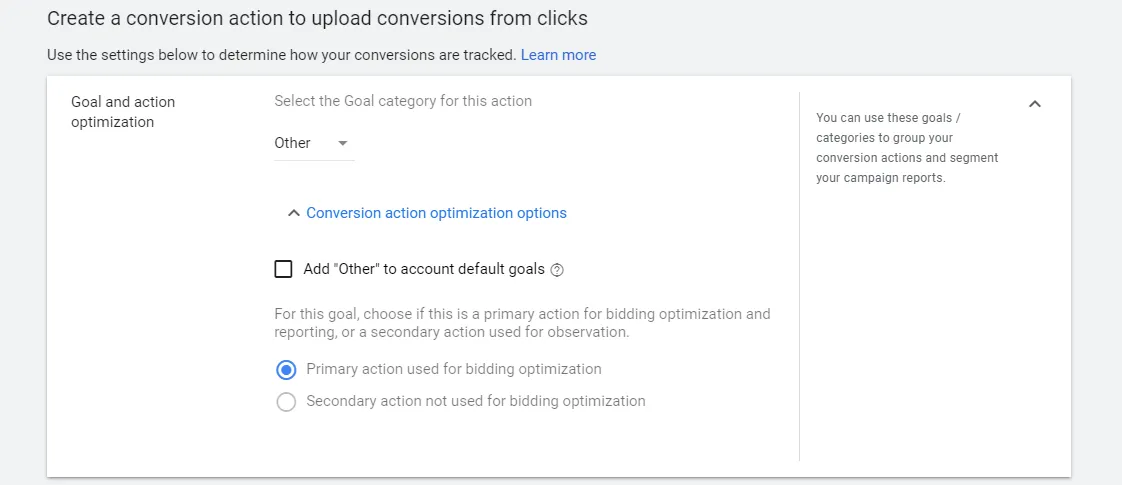
- As an ecommerce advertiser, consider setting a conversion value based on a sale’s profitability rather than its revenue, to account for varying margins for different products. Aligning the values you report with the KPIs your business cares about can simplify a lot of things – for example, choosing the right target ROAS.
- If some of your conversion value increases or decreases based on things that happen offline, use one of the offline conversion tracking tools described earlier in this article.
- If you report conversions to Google after they happened, or you restate values later on, try to do this at least daily so the machine learning gets fresh data all the time.
- When using Conversion Value Rules, only communicate to Google things that may not be observable through Smart Bidding e.g. profit margin, customer lifetime value, upsell opportunities, etc.
- Use one of these key product features from Google to adjust values:
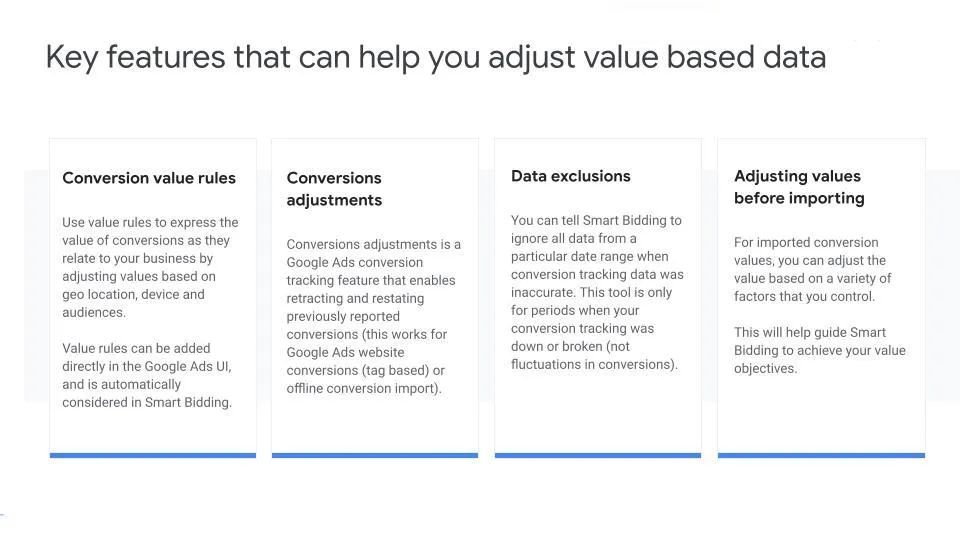
Structure and Targets
Account structure and targets go hand-in-hand because which targets you can set depends on how your account is structured. If you need to have different targets for different parts of your business, you should maintain at least one campaign for each.
While many advertisers may have heard Google’s call for a simpler account structure, bear in mind they’re asking advertisers to remove unnecessary complexity. So don’t maintain multiple campaigns for the sake of having the same keywords in different match types. But do maintain separate campaigns if you sell seasonal products that will have different targets as the seasons change.
- Decide at what level your conversion actions make sense. You can set them cross-account, at the account level, or by campaign or groups of campaigns. When Google’s algorithm predicts conversion rates, it uses all data associated with a conversion action’s scope. This means you can have a single conversion action at the MCC level that guides all bid decisions across multiple accounts for the same company. Or if you have a campaign with a unique one-off goal where you don’t want other campaigns to impact its predictions, set it up with a campaign-level conversion action.
- Maintaining a minimum conversion volume is becoming less important as Google’s machine learning improves and is able to draw inferences from system-wide data. That said, most advertisers we talk to find automation performs better with campaigns that have more conversions. Target at least 30-50 conversions per month before enabling automated bids. Before then, use Enhanced CPC bidding or Maximize Conversion Value (with no tROAS) to build up data. And consider adding micro-conversions if you find yourself struggling to meet the conversion threshold when relying solely on your primary conversion action.
- When testing value-based bidding with Google’s Experiments framework, you need double the number of conversions. So building on the previous point, aim for 30-50 conversions per month for both the control and experiment groups. Otherwise, you may need to expand your testing period beyond 1-2 months to reach conclusive results.
- If you followed the advice from the previous section and are reporting profits rather than revenue, you can now set targets based on true goals. Before reporting profits in conversion tracking, some advertisers use the tROAS to emulate profits. For example, in a campaign where the typical product has a 50% margin (the cost of the goods sold is half the price charged for the item), an advertiser can set a 200% tROAS knowing that if they hit that ROAS exactly, they will break even. Instead, when they report profits, they can now set a tROAS of 100% to achieve the same thing and avoid confusion about why they have a 200% tROAS when they would have been happy with 100%.
- Set the initial target ROAS based on historical performance. The simple math is conversion value (such as revenue) divided by ad cost, for at least the past 30 days. Setting it too aggressively may severely limit volume.
- Use profitability as a guide for setting the right budgets & ROAS targets with Performance Planner.
- When you expect a sudden fluctuation in user behavior that will impact conversions, consider setting a seasonality adjustment or modifying the tROAS. The benefit of a seasonality adjustment is that you can set an end date and machine learning will ignore data from the seasonality event for its future predictions.
Testing and Hygiene
With conversion tracking reporting the right thing and targets set to achieve actual business goals, advertisers are ready to start experimenting with value-based bidding. But just like with any test, here are a few considerations to keep in mind:
- Build up enough conversion history before starting a test. At least 3 conversion cycles or 4 weeks is recommended, whichever is longer. That means that if your typical conversion takes 15 days, you should wait 45 days before turning on your target ROAS. Use the Path Metrics report in the Attribution section in Google Ads to learn what your typical conversion delay is.
- If you have a tROAS, uncap your budgets so that the system can find incremental conversions within your target. If you do not have a tROAS, use Maximum Conversion Value as the bid strategy and keep your budget cap in line with your expected daily spend goals.
- Google recommends not changing targets more than 20% or more frequently than every 2 weeks. These are guidelines and it’s okay if you don’t follow them. Your business objectives should take priority. Keep in mind that a big change in your target can bump Smart Bidding into its learning phase, but that does not mean Google’s machine learning forgot everything from the past. It simply means that a large swing in your target is making your ads eligible for a significantly different set of queries for which Google may not know much about your expected performance. For the same queries you’ve had before, it’ll be business as usual. For the new queries, performance may fluctuate and that may make your averages look a little strange for a while, but you didn’t break machine learning.
- A best practice of gathering conversion value at observation mode first (without setting bids) for Offline Conversion Imports is 2-4 weeks.
- If something goes wrong and conversion data is broken – for example, if your website goes down – use a data exclusion to let machine learning know that it should ignore data from that period for making future predictions.
- As with any test, minimize big changes. For example, changing the landing page or your offer could dramatically impact conversion rates and Google’s algorithms won’t necessarily know if the change was due to this or something within its own control like bids or broad matches. If you have to make changes to your campaigns during the test period, make the same change to both the control and experimental groups.
- Keep in mind when switching to value-based bidding:
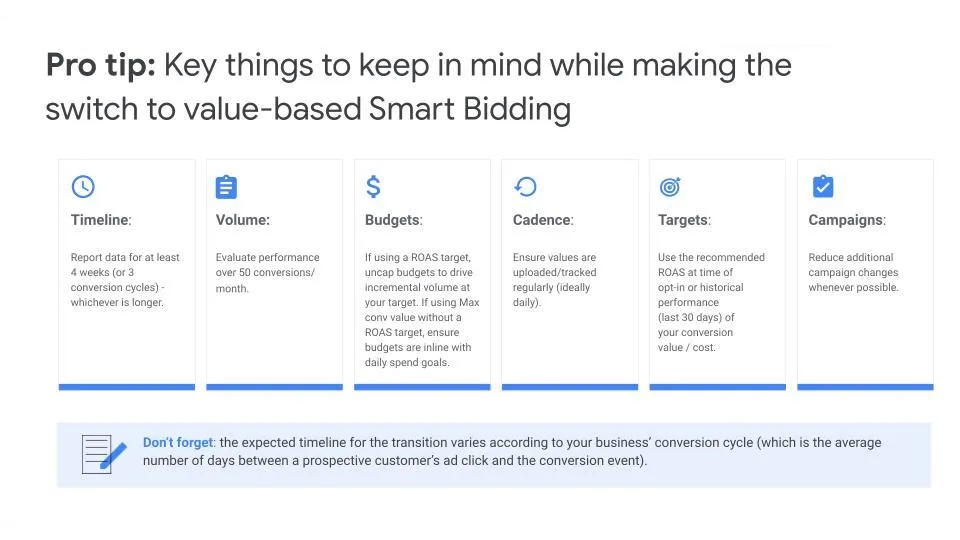
Evaluating Performance
Finally, with tests underway, it’s important to understand how to evaluate performance the right way so you avoid making incorrect decisions.
- Machine learning needs a bit of time to learn; it’s called machine learning after all! So give it 1-2 weeks to get through the ramp-up period and then ONLY consider data from that point forward when deciding what’s the winner and what’s the loser. Optmyzr’s [Campaign Experiments](Campaign Experiments by Optmyzr: Google Ads Experiments Made Easy) tool will help you see all experiments in one place and accounts for the ramp-up period.
- Experiments shouldn’t be terminated too soon; 4-8 weeks is generally the right amount of time to let an experiment accrue enough data that isn’t biased by time factors. Of course, the exact amount of time depends on the volume of the campaigns so be sure to look for statistically significant results.
- When automating value-based bids, your metrics for deciding winners and losers should focus on revenue maximization or conversion value maximization, so don’t pick a winner based on an unrelated metric like CTR for example.
- Keep in mind that most campaigns have conversion lag. So when analyzing performance, ignore the most recent days where conversion reporting is likely still incomplete. You can use Google’s attribution reports to find the typical conversion lag for each of your campaigns.
- Google’s Bid Strategy Report already does a lot of the performance analysis for you. Use tools like Optmyzr to delve deeper into the numbers and produce additional reports your clients or boss might be asking for.
Common Pitfalls (As Identified by Technical Specialists)
Besides using the above best practices for starting with value-based bidding in your account, beware of some of the most common pitfalls we’ve seen.
1. Your ROAS goal should not be too aggressive
It would be nice if automation was a magic bullet that could instantly quadruple your performance, but chances are this won’t work. It’s better to start with the recommended tROAS based on historical performance so that the system gets a good baseline. From there, you can slowly change the tROAS and periodically review if these small tweaks are getting you closer to where you’d like to be. The Optmyzr Rule Engine is a great tool that can automate these periodic small tweaks to your targets.
2. Don’t analyze performance during the learning period
We said it in the guidelines but we’ll say it again because too many advertisers can’t wait to see results so they jump the gun and make decisions too quickly. The system takes time to calibrate and settle in, so give it the required 1-2 weeks to do this before you start analyzing results.
3. Don’t forget about conversion delays
We said this one before too but it’s another all-too-common mistake to judge a campaign by the most recent performance we have access to. And while Google Ads will report clicks/cost/etc. in a matter of minutes for most campaigns, conversions take time because people take time to make up their minds. If you judge a campaign on this partial data, you’re bound to make bad decisions. Said another way, remember that Google Ads data is click-centric. If a click today leads to a conversion in 5 days, that conversion will show up in the report for today’s data after 5 days. The data you look at may not tell you the complete and final picture. So be sure to exclude performance during the conversion delay period.
4. Don’t look at the wrong metrics
For better or for worse, Google has really trained advertisers to care about click-through rate, conversion rate, and yes, even ROAS. But don’t lose sight of how those metrics relate to your business goals. We once talked to an advertiser who told their agency they had to get a 400% ROAS to keep the business. They dutifully met that target until one day they asked the client why they insisted on a ROAS that was actually decreasing profits. The client sheepishly admitted they got 300% ROAS from the last agency and thought 400% would be better.
5. Not assigning value to conversions that matter
The whole premise of value-based bidding is to help machine learning understand the true value of conversions to your business. So don’t skip assigning values to all your conversion actions. But also don’t get stuck on setting the exact right amount. It’s fine to estimate, measure and iterate.
6. Poor campaign structure
Old campaign structures can really hamper results. For example, you should not separate campaigns by keyword match type, or by device type. The former is almost always unnecessary, the latter likely is less necessary than it once was. Your account structure should be as simple as possible while still enabling you to set different goals based on your business needs.
What A Successful Value-Based Bid Strategy Looks Like
The transition from a conversion-based mindset to value-based bidding can be rewarding, but only when done right. That starts with understanding how Smart Bidding makes decisions in order to meet it halfway.
Advertisers around the world have made mistakes like jumping into Smart Bidding without taking prerequisite measures, evaluating performance too early when testing a new bid strategy, and not realizing that Smart Bidding already takes into account observable conversion data from all your campaigns.
Value-based bidding is the next level of account optimization after you’ve run the course with a conversion-based methodology. The guidelines we’ve covered in this article will help you see better results more quickly by avoiding some of the most common pitfalls we’ve seen advertisers fall for when deploying the tools from Google.
Be the advertiser who succeeds by having a plan, sets things up to succeed from the outset, understands the limitations of Google’s decision-making algorithms, and feeds updated and relevant data to align the algorithm with your business goals.
Some images courtesy of Google.


Unlock the power of value-based bidding
Score audience segments, optimize conversion value rules, track campaign experiments, and get faster & more effective results with Optmyzr's value-based bidding tools.
Try Optmyzr now





